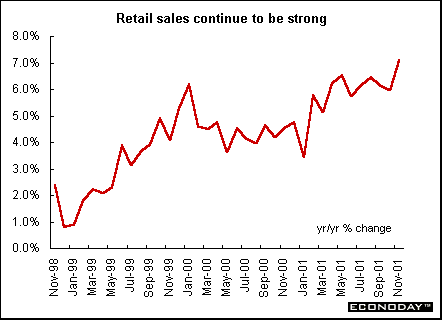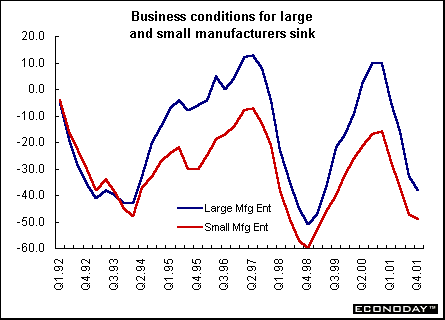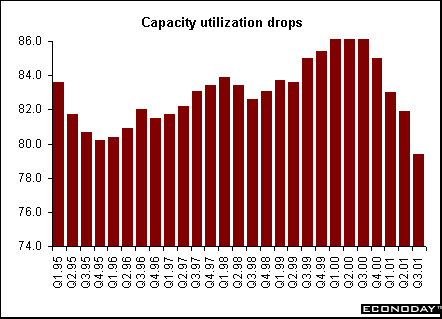
Indicator scoreboard
Germany - November wholesale price index fell 1.0 percent and 1.9 percent when compared with last year. The declines were largely due to lower energy and seasonal food prices. Energy prices fell 3.5 percent and 12.4 percent on the year. Excluding oil products, wholesale prices fell 0.6 percent and 0.2 percent when compared with last year. Many analysts view the WPI cautiously and think the producer price index gives a better picture of the German inflation situation.
October seasonally and calendar adjusted real retail sales excluding autos and gasoline fell 2.2 percent and 1.8 percent when compared with last year. Total retail sales, which include autos and gasoline, were down 1.5 percent on the month and 0.2 percent when compared with last year. Retail sales excluding autos were down 0.3 percent and 2.4 percent when compared with last year.

October seasonally adjusted merchandise trade surplus was E8.3 billion, up from an E6.7 billion surplus in September and up from an E6.5 billion surplus in October 2000. Exports were up 0.6 percent but down 1.7 percent on the year. Imports were down 2.6 percent on the month and 5.8 percent on the year.
France - October seasonally and workday adjusted manufacturing output dropped 0.7 percent and 1.0 percent on the year. Industrial output fell 0.6 percent and 0.3 percent when compared with last year. All sectors posted declines led by autos, which were down 2.6 percent. Consumer goods output fell 0.5 percent after a 1.8 percent drop in September. Continued drops for semi-finished goods and capital goods output confirmed the weakness of industry demand.
Italy - October seasonally and workday adjusted industrial production fell 0.2 percent and 2.8 percent when compared with last year. The index has now posted four consecutive declines. Consumer goods output rose 0.4 percent while investment goods dropped 0.3 percent and intermediate goods fell 0.4 percent.
Britain - November retail price index (RPI) fell 0.4 percent but was up 0.9 percent when compared with last year. The retail price index excluding mortgage interest payments (RPIX) slipped 0.2 percent but was up 1.8 percent on the year. The RPIX, the Bank of England's inflation measure, remains below its 2.5 percent inflation target.

November producer output prices dropped 0.4 percent and were down 1.0 percent when compared with last year. This was the lowest level of annual output price inflation since records began in 1958. The drop in output prices was mainly due to a fall in the price of petroleum products. These fell 4.1 percent and 15.1 percent on the year. This was partly offset by a 0.5 percent monthly rise in food costs, mainly reflecting increases in lamb and grain mill product prices Excluding food, beverages, tobacco and petroleum products, seasonally adjusted core output prices remained unchanged on the month and rose 0.1 percent on the year. Seasonally adjusted input prices declined 1.0 percent on the month and were 11.1 percent below levels of a year earlier.
November claimant count unemployment rate remained at 3.2 percent although the number of unemployed rose for the second consecutive month. It was the first back-to-back monthly increase since December 1992. Unemployment rate as measured by the International Labor Organization rose to 5.1 percent for the three months to October from 5.0 percent in the three months to September. The number of unemployed rose by this measure as well. The number of manufacturing jobs declined by 13,000 following an 18,000 drop in September. Over the past year 148,000 jobs have been lost.

October average earnings rose 4.4 percent but remain below the 4.5 percent threshold seen as consistent with meeting the inflation target. Public sector earnings eased to 5.7 percent in October from 5.8 percent the previous month. Private sector earnings remained stable at 4 percent for the three months ending in October. Despite the sharp slowdown in the manufacturing, earnings in the sector continue to outstrip those in services. Manufacturing earnings eased to 4.3 percent in October from 4.5 percent in September. Services earnings growth rose to 4.2 percent from 4.1 percent. Excluding bonuses, earnings growth in October remained stable at 5 percent on the year.

November retail sales volumes rose 1.3 percent and 7.1 percent when compared with last year. Non-food store sales jumped 1.9 percent and by 8.7 percent on the year. Clothing and footwear sales climbed 2 percent and 11.3 percent on the year. Based on non-seasonally adjusted data, the average weekly value of retail sales in November was 6.8 percent higher than in November 2000.

Asia
Japan - December Tankan survey showed that confidence among Japanese corporations about prospects for the economy have deteriorated sharply. The diffusion index for large manufacturers fell to minus 38, indicating that for every 100 companies that were optimistic, 138 were pessimistic. The previous quarter registered a minus 33 reading, while in June it was minus 16. The large non-manufacturers diffusion index fell to minus 22 from minus 17 in the last quarter. Both manufacturers and non-manufacturers expect lower profits this year with large manufacturers forecasting a 34.4 percent plunge.

November wholesale prices fell 0.2 percent and 1.4 percent from a year earlier. This was their 14th straight drop and the biggest since July 1999.
October seasonally adjusted machinery orders fell 10.1 percent and 26.6 percent when compared with last year. This was the steepest decline in a decade.
November bankruptcies totaled 1,813 companies, 15.7 percent more than a year earlier, according to a report from Tokyo Shoko Research Ltd. That followed an 11.3 percent increase in October and was the biggest gain in 13 months. The failed companies owed 1.87 trillion yen ($15 billion).
October seasonally adjusted factory usage fell 0.8 percent and 9.9 percent when compared with last year to the lowest level since 1978 when records were first kept. Capacity fell 2.8 percent led by chipmakers, computers and other electric machinery.
Australia - November unemployment rate slid to 6.7 percent from 7.1 percent in October. The seasonally adjusted number of jobs rose by 4,100. The economy added 16,200 full time jobs and shed 12,000 part time positions. The participation rate, which measures the number of people in work or looking for jobs as a percentage of the population, fell to 63.5 percent from 63.8 percent.

Americas
Canada - Third quarter production capacity utilization fell to 79.4 percent from a revised 81.9 percent in the second quarter, the largest single quarter decline on record. The rate fell because of slumping demand in the high tech sector and, to a lesser extent, lower demand for automotive products. Capacity usage rates dropped in all the groups making up the industrial aggregate: forestry and logging; mining and oil and gas extraction; electric power generation, transmission and distribution; construction; and most of the industry groups in the manufacturing sector. Manufacturers operated at 77.4 percent of their capacity in the third quarter, down 2.6 percentage points from the second. Sixteen of 21 major manufacturing groups had lower rates. The drop in manufacturing was largely driven by declines in computer and electronic products, automotive products, chemicals, wood products, and paper products.

 |


Introduction • Global
Stock Market Indexes • Recap of Global Markets
• Currencies • Indicator
Scoreboard

The Bottom Line •
Looking Ahead
|